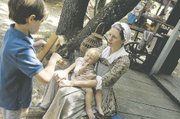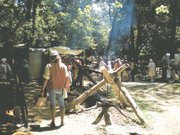For more than a thousand attendees, the Claude Moore Colonial Farm’s Market Fair was a trip back in time.
The fair, which took place on July 18 and 19, featured food, drink and entertainment in a colonial setting. Attractions included puppet shows, a wide variety of food and demonstrations of pottery, spinning and fencing.
"It really does suit all ages," said Farm Director Anna Eberly, whose work for the event’s first day included cutting roast chickens. Some 160 volunteers were expected to attend each day, according to Eberly.
One of those volunteers was Vermont resident Meg Baker, who first served at the Market Fair when she was 10.
"It’s a great place for kids," Baker said. She attended with her 3-year-old son Asa and her 3-month-old son Toby. Asa had asked her beforehand, "Are we going to the fair? Are we going to the fair?"
Baker used to work at the Claude Moore farmhouse during Market Fair events. After 22 years, she said, "There are a lot more people coming."
THE CLAUDE MOORE COLONIAL FARM is located in McLean near CIA headquarters. It demonstrates the lifestyle of a low-income family in the year 1771, according to its Web site. The market fair runs only three times a year. The next event will take place on the third weekend of October.
Andrew Stoddard visited the fair with his 18-month-old daughter, Emily. Stoddard said that he has attended "every single one" since the mid-1990s, and plans to attend next year as well. He and his daughter sampled the sausage, beef jerky, pickled egg and meat pie available on the first day of the event.
"It’s nice to see a lot of people here," said Stoddard. After Claude Moore began advertising the event, he said, the attendance levels increased.
The Market Fair began in 1982 with fewer booths and no food, according to Eberly. Since then, she said, "It’s really expanded." Although weather can be a difficult factor, "everything runs pretty smoothly," Eberly said.
Many of those who helped out at the fair wore handmade period clothing. Volunteer jobs ranged from food preparation to acting and shop keeping, with both children and the elderly assisting.
Arminda Pappas visited on the first day of the fair, which allows her "to get an idea of how people used to live," she said. She enjoyed seeing the volunteers in their period dress and got a taste of colonial food.
ONE AREA OF THE FAIR featured a pottery exhibition. Rudy Tucker, who makes wood-fired stoneware, enjoyed demonstrating his craft to the fair audience. Although he also works as a salesman for his art, that "gets kind of boring for me," Tucker said.
The potter has featured his work at other colonial locations, including Poplar Forest, one of Thomas Jefferson’s homes, and Mount Vernon.
A sign outside the fairgrounds called the event "A time when Citizens can … put aside the routine Chores and Cares of Life." That may have been one of Eberly’s motives for putting on the Market Fair.
"We like for everyone to be happy," she said.




